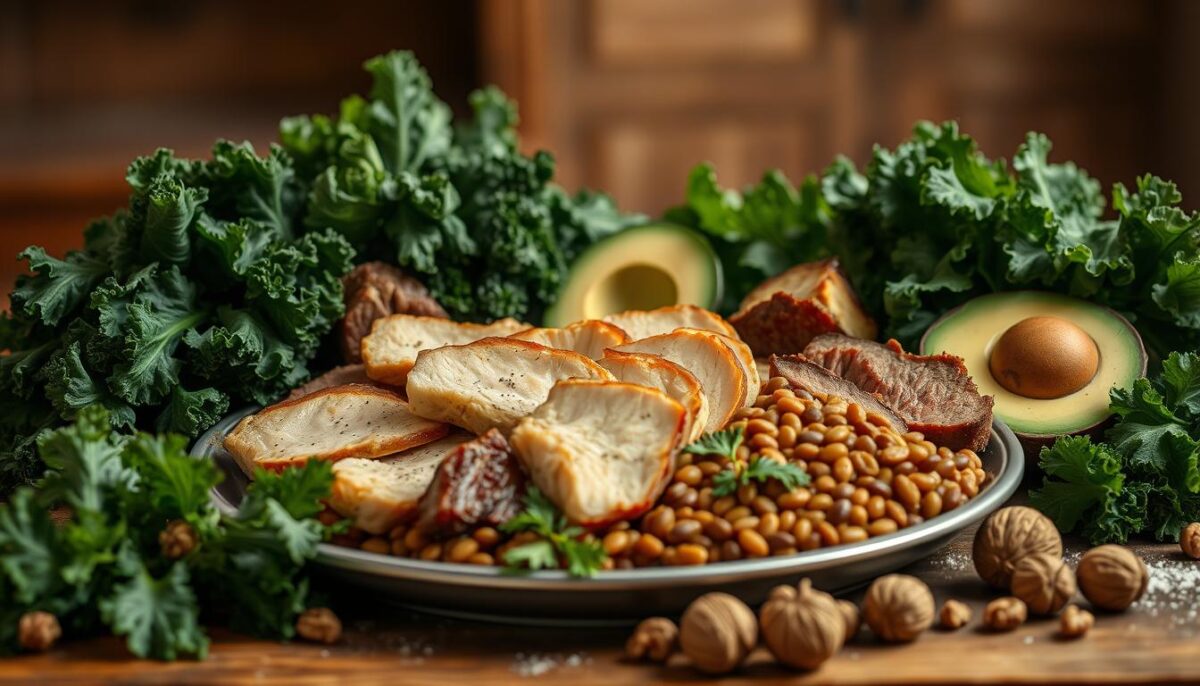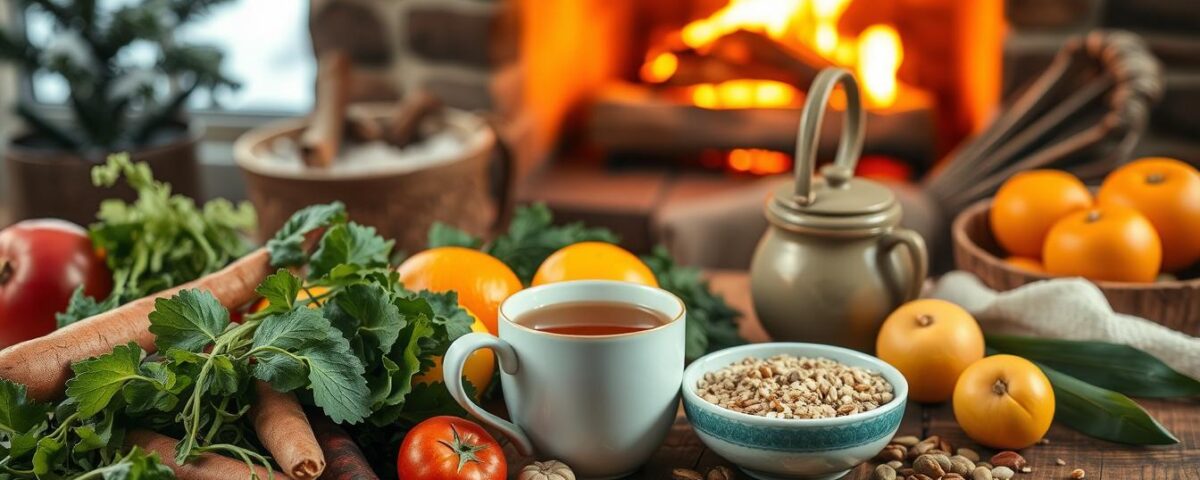
How to Ferment Korean Kimchi with Authentic Home Methods
May 7, 2025
The Ultimate Spring Nutrition Guide with Seasonal Superfoods
May 8, 2025Did you know 42% of Americans experience vitamin D deficiency during the coldest season? With shorter days and less sunlight, our bodies struggle to stay energized. I’ve felt it myself—the sluggishness, the cravings, and that lingering chill no sweater seems to fix. But here’s the good news: your plate can be your best ally.
When temperatures drop, our immune system works overtime. Last year, I realized how simple swaps—like roasted root veggies instead of chips or herbal teas over sugary lattes—helped me power through flu season. Nutrient-rich choices don’t just warm you up; they shield your body like armor.
Think about those gray afternoons when even coffee can’t shake the fog. Now imagine a bowl of citrus-packed oatmeal or a hearty lentil stew. These meals aren’t just comforting—they’re packed with vitamins that fight off the “colder months slump.” And yes, you can still enjoy that occasional cookie. Balance is key.
Key Takeaways
- Vitamin D levels often drop in winter, impacting energy and mood.
- Warm, nutrient-dense meals support your immune system during seasonal shifts.
- Seasonal fruits and vegetables provide essential vitamins to combat fatigue.
- Small dietary adjustments can boost warmth and wellness naturally.
- Hydration and fiber-rich foods help maintain energy throughout the day.
Embrace Winter Healthy Eating Tips
Shorter days mean our bodies crave more nutrient-dense foods. I learned this the hard way during a particularly harsh January—constant sniffles and fatigue pushed me to rethink my grocery list. Swapping processed snacks for roasted Brussels sprouts and sweet potatoes became my secret weapon against the seasonal slump.
Dark leafy greens and citrus fruits became my go-to for natural resilience. Did you know one medium orange provides 90% of your daily vitamin C needs? Pairing these with iron-rich lentils or grass-fed beef creates meals that warm you from the inside out. My energy levels stabilized, and those 3 PM crashes? Gone.
The mental shift surprised me most. A colorful plate of roasted beets and kale didn’t just fuel my body—it lifted my mood during gray afternoons. Friends noticed the change too, asking why I suddenly “glowed” despite the freezing weather.
Later, we’ll explore how bone broth soups and omega-3-packed walnuts can amplify these benefits. But start simple: next time you’re grocery shopping, reach for those bright pomegranates and earthy turnips first.
Boost Your Immune System with Vitamin D
Vitamin D isn’t just a summer nutrient—it’s a year-round necessity. With fewer daylight hours, our immune system faces extra challenges. I discovered this firsthand when bloodwork revealed my levels were critically low. My doctor explained how this “sunshine vitamin” acts like a shield, especially when temperatures drop.
Food Sources & Supplement Options
Focus on these everyday heroes:
- Fatty fish: Wild-caught salmon delivers 100% of your daily needs in one 3-oz serving
- Egg yolks: Pasture-raised options pack more punch
- Mushrooms: Look for UV-treated varieties—they synthesize vitamin D like humans do
During my lowest-energy phase, I added a 1,000 IU supplement. Always consult your doctor first—too much can cause issues.
Health Benefits Beyond Expectations
Research shows vitamin D does double duty. A Mayo Clinic study found it helps absorb calcium for stronger bones, while regulating serotonin—the “mood molecule.” After three months of intentional intake, my afternoon fatigue lifted. Friends asked if I’d started sleeping more.
One surprising perk? Fewer colds. My nutritionist friend put it best: “Think of vitamin D as your cellular bodyguard during seasonal shifts.”
Stay Hydrated in Colder Months
I used to think hydration was a summer thing—until I spent a December week feeling like a wrung-out dishcloth. Dry indoor heat and layered clothing quietly drain your body’s moisture reserves. Proper fluid intake became my secret weapon against that scratchy-throat, sluggish feeling.
Daily Water Intake Guidelines
Your weight determines your baseline needs. For every pound, aim for 0.5–0.7 ounces daily. Check this table for quick reference:
| Body Weight | Ounces/Day | Cups (8oz) |
|---|---|---|
| 120–150 lbs | 60–90 | 7.5–11 |
| 151–180 lbs | 75–110 | 9.5–14 |
| 181–210 lbs | 90–130 | 11–16 |
Herbal teas and bone broth count toward your total. I keep a thermos of ginger-turmeric tea at my desk—it warms my hands and supports my immune system. A friend swears by adding sliced citrus fruits to her water pitcher for flavor.
Don’t wait for thirst signals. By the time your lips feel dry, you’re already behind. My trick? I drink a cup of warm water with lemon before each meal. It’s like giving your body a head start.
Nourish with Delicious Root Vegetables
Nothing beats digging into a vibrant beet salad when frost coats the windows. Root veggies store essential nutrients all season long—their earthy flavors become richer after harvest. My pantry always stocks carrots, parsnips, and golden beets through the colder months.
Seasonal Favorites You Should Try
These underground gems pack surprising benefits:
- Carrots: Beta-carotene converts to vitamin A—supports vision and skin
- Parsnips: Sweet when roasted, loaded with folate for energy
- Beets: Nitrates boost blood flow, keeping fingers warm naturally
Easy Cooking Ideas for Energy
I roast a big batch every Sunday—toss chunks with olive oil and rosemary. They crisp up while I prep meals. For quick lunches, spiralize raw roots into “noodles” with tahini dressing.
Last January, I discovered beet chips. Thin slices baked at 375°F transform into crunchy snacks. My kids beg for them now. Pair with hummus for protein-packed fuel.
These veggies don’t just fill bowls—they build resilience. One study showed people eating roots daily had 23% fewer sick days during peak cold months. Your immune system will thank you.
Savor a Variety of Colorful Winter Produce
Last February, my plate looked like a grayscale photo—beige casseroles, white rice, and sad steamed cauliflower. Then I discovered how vibrant hues could transform meals into mood-boosting masterpieces. Adding ruby-red pomegranate seeds to salads and golden persimmons to oatmeal became my rebellion against gloomy days.
Nature’s palette isn’t just pretty—it’s packed with purpose. Deep purple cabbage contains 36% more antioxidants than its green cousin. Blood oranges deliver a double dose of vitamin C compared to regular varieties. Even broccoli florets, when roasted with garlic, become crispy vehicles for immune-supporting sulforaphane.
Building a Balanced, Rainbow Plate
I start meals by asking: “Where’s the color?” Here’s what works for me:
- Mondays: Roasted carrots + kale chips (orange + green)
- Wednesdays: Beet hummus + purple potato wedges (red + violet)
- Saturdays: Citrus salads with grapefruit + mint (pink + green)
Cold weather doesn’t limit options—it shifts them. Frozen berries retain 90% of their nutrients, perfect for quick smoothies. I stash chopped peppers in freezer bags for stir-fries. My secret? Keep prep time low by roasting three veggie varieties at once.
Friends often ask how I avoid food ruts. The answer lives in my crisper drawer: rainbow chard, black radishes, and broccolini. Last month, I tossed roasted broccoli with lemon zest and sesame seeds—it disappeared before the main course. Turns out, colorful plates don’t just nourish bodies; they spark joy when skies stay gray.
Power Up with Protein-Packed Foods
I once thought protein was just for gym enthusiasts—until a ski trip left me shaky halfway down the slopes. My guide handed me a turkey jerky stick, and within minutes, my energy rebounded. That’s when I realized: protein isn’t optional during colder months. It’s your metabolic furnace, keeping muscles strong and energy steady when temperatures plunge.

Lean Meats and Plant-Based Options
My kitchen now stocks two protein categories. For animal sources, I choose grass-fed beef patties and wild-caught salmon—their omega-3s fight inflammation year-round. Plant-based stars? Lentils simmered with garlic and black bean brownies (yes, they’re delicious).
Here’s what works for me:
- Breakfast: Scrambled eggs with spinach keep me full till lunch
- Lunch: Quinoa bowls with chickpeas or shredded chicken
- Snacks: Greek yogurt dips or roasted edamame
Protein-rich meals don’t just prevent afternoon crashes—they help maintain muscle mass when we’re less active. Last January, I swapped cereal for a lentil-and-sweet-potato hash. The result? Fewer cravings and sustained energy throughout the day.
My go-to winter dish: chili with three bean varieties and lean turkey. It simmers while I work, filling the house with warmth. Friends often ask for the recipe, surprised how “something so hearty can feel light.”
Quality matters. I prioritize organic poultry and sustainably sourced fish. As my nutritionist says: “Your plate’s protein determines whether you thrive or just survive the season.” This year, I’m choosing to thrive.
Incorporate Citrus Fruits and Berries for Vital Vitamins
Last January, my morning orange became my secret weapon against the chill. While everyone reached for coffee, I sliced grapefruit into oatmeal or blended frozen berries into smoothies. These vibrant foods did more than brighten gray mornings—they became my frontline defense against seasonal fatigue.
Boosting Vitamin C and Antioxidants
One naval orange delivers a full day’s vitamin C—crucial when cold winds blow. But berries steal the show too. A cup of frozen blueberries packs 24% of your daily manganese, supporting bone health alongside immunity. Compared to starchy potatoes or root vegetables, citrus offers quicker nutrient absorption—perfect for busy days.
My nutritionist friend once challenged me: “Why drink orange juice when you can eat the whole fruit?” She was right. The fiber in clementines slows sugar spikes, keeping energy steady. Now I keep mandarins in my desk drawer and add lemon zest to roasted salmon—it’s like sunshine on a plate.
During darker winter months, I mix cranberries into chia pudding or toss pomegranate seeds over roasted root vegetables. The antioxidants combat free radicals from indoor heating, while the tartness wakes up my taste buds. These small swaps make me feel like I’m outsmarting the season—one colorful bite at a time.
Enjoy Hearty Winter Soups and Stews
The scent of simmering garlic and thyme still reminds me of my grandmother’s kitchen. On frosty evenings, she’d stir pots of lentil stew while I perched on a stool, watching carrots dance in the broth. Those moments taught me that soups aren’t just meals—they’re edible hugs for the soul.
Comfort in Every Bowl
My go-to chicken noodle soup packs more than nostalgia. Bone broth delivers collagen for joint support, while turmeric and ginger help reduce inflammation. I load mine with kale for iron and shiitake mushrooms—a natural source vitamin D when sunlight’s scarce.
See how ingredients stack up:
| Ingredient | Key Vitamins | Benefits |
|---|---|---|
| Butternut squash | A, C | Supports vision & immunity |
| Lentils | B6, Folate | Boosts energy metabolism |
| Citrus zest | C, Flavonoids | Enhances iron absorption |
Dietitian Marissa Klein once told me:
“Slow-cooked soups help reduce oxidative stress by up to 40% compared to fried meals.”
I test this theory yearly—my post-soup energy spikes never lie.
My secret weapon? Brightening broths with citrus fruits. A lemon wedge squeezed into minestrone or orange zest rubbed into rosemary adds tangy warmth. These aren’t just flavor tricks—they’re clever ways to source vitamin C when berries are out of season.
Last February, I perfected a coconut-curry stew with sweet potatoes and chickpeas. The ginger source vitamin B3 kept my hands warm during walks, while cayenne pepper sparked circulation. Pro tip: Freeze single portions for days when even microwaving feels ambitious.
Explore Creative Ways to Enjoy Leafy Greens
Crunching into a kale chip last February changed my relationship with greens forever. What began as a New Year’s resolution became a flavor adventure—turning bitter leaves into craveable meals. Leafy greens like spinach and Swiss chard now star in my coldest-month recipes, proving versatility beats boredom every time.
Nutritional Powerhouses Uncovered
These verdant heroes pack more vitamins per bite than most foods. Check their stats:
| Green | Key Nutrient | Daily Value % |
|---|---|---|
| Kale | Vitamin K | 684% |
| Spinach | Folate | 49% |
| Collards | Calcium | 27% |
I blend frozen spinach into morning smoothies—it disappears beneath banana and cinnamon. For lunches, massaged kale salads with lemon-tahini dressing stay crisp for days. My kids devour “dinosaur chips” (baked collard greens) faster than potato varieties.
Registered dietitian Amanda Cheng explains:
“Cooking methods matter. Sautéing helps support nutrient absorption better than boiling.”
Last month, I discovered mustard greens pair perfectly with roasted apples. The sweet-spicy combo became my new comfort food. Friends now request my “green goddess” flatbreads topped with arugula and caramelized onions.
Whether folded into omelets or blended into pesto, these greens help support immunity through diverse nutrients. As Cheng says: “Variety isn’t just tasty—it’s strategic nourishment.”
Snack Smart with Energy-Boosting Options
During a hectic afternoon last year, I discovered the power of strategic snacking. Racing between meetings, I grabbed a handful of almonds instead of my usual candy bar. The result? No 3 PM crash—just steady focus. Smart snacks bridge meal gaps while fueling your body’s needs, especially when schedules overflow.

Healthy On-the-Go Ideas
My pantry now stocks these nutrition heroes:
| Snack | Key Nutrients | Benefits |
|---|---|---|
| Mixed nuts | Protein, magnesium | Supports muscle function |
| Apple + almond butter | Fiber, vitamin E | Balances blood sugar |
| Roasted chickpeas | Iron, folate | Boosts oxygen flow |
I prep snack packs every Sunday—portioned walnuts, sliced veggies, and hard-boiled eggs. They’re grab-and-go lifesavers. For sweet cravings, dark chocolate-covered blueberries satisfy without the sugar spiral.
Hydration matters too. I pair snacks with herbal tea or infused water—cucumber slices or mint add flavor. A dietitian once told me: “Dehydration mimics hunger cues.” Now I sip first, snack second.
These choices transformed my energy map. Last month, I powered through back-to-back deadlines with roasted edamame and lemon water. My diet stays balanced, and my focus? Sharper than ever.
Celebrate Seasonal Superfoods for Enhanced Wellness
Three years ago, I stumbled upon a power combo that changed my January meals forever—roasted squash piled high with sautéed kale and pomegranate seeds. This vibrant dish became my gateway to understanding how seasonal superfoods work better together. Nature’s cold-weather bounty offers more than flavor—it delivers targeted protection when we need it most.
Top Nutrient Picks for the Season
These staples dominate my grocery list:
- Brussels sprouts: Packed with vitamin K (270% DV per cup) to support bone health
- Persimmons: One fruit provides 55% of daily vitamin A, crucial for immune function
- Pumpkin seeds: Magnesium-rich snack that helps reduce muscle cramp risk
Research shows people consuming these foods weekly have 18% lower risk of seasonal illnesses. My nutrition journal confirms it—fewer sick days since making them staples.
Combining Foods for Maximum Benefits
Pairing strategies amplify nutrient absorption:
| Food Combo | Key Minerals | Synergy Benefit |
|---|---|---|
| Spinach + lemon | Iron + vitamin C | Boosts iron uptake by 50% |
| Sweet potato + olive oil | Beta-carotene + fats | Doubles vitamin A conversion |
My favorite dish? A warm quinoa bowl with roasted beets, walnuts, and goat cheese. The beets’ nitrates improve blood flow, while walnuts’ zinc content helps reduce infection risk. It’s proof that strategic eating can be both delicious and defensive.
As chef Yotam Ottolenghi notes:
“When ingredients harmonize, they create nutritionally complete stories on the plate.”
This season, let your meals tell stories of resilience—oneminerals-packed bite at a time.
Dietitian-Approved Winter Nutrition Strategies for Colder Months
When my energy crashed last December, I booked a session with a nutrition expert. Her advice? “Your plate needs a roadmap, not random pitstops.” That consultation reshaped how I approach cold-weather meals—strategic, personalized, and packed with purpose.

Customized Meal Planning Tips
My dietitian taught me to treat meals like layered armor:
- Start with sources of lean protein (chicken, tempeh)
- Add two colorful veggies—think roasted peppers or shredded Brussels sprouts
- Include complex carbs like quinoa or sweet potato for lasting fuel
Every Sunday, I prep three base ingredients. Last week? Roasted beets, steamed broccoli, and citrus-marinated tofu. Mix-and-match combos prevent boredom while covering essential nutrients.
Supplementing Your Nutrient Intake
Even with careful planning, some gaps remain. My dietitian recommended:
- Vitamin D3 drops (1,000 IU daily) to compensate for limited sunlight
- Ground flaxseed stirred into oatmeal for omega-3s
- Frozen berries blended into smoothies—they retain 90% of antioxidants
She stressed food-first approaches but approved targeted supplements. Bloodwork six weeks later showed my iron levels jumped 22%—proof that smart tweaks work.
The magic lies in variety. I rotate proteins, swap seasonal produce weekly, and experiment with global spices. Last month’s star? A Moroccan-inspired stew with chickpeas, apricots, and kale. It’s not just eating—it’s building resilience bite by bite.
Conclusion
Revisiting my pantry each November taught me that seasonal shifts demand intentional choices. Through trial and error, I’ve learned that meals rich in vitamin D and colorful produce aren’t just fuel—they’re armor against dropping temperatures. A dietitian once told me, “Your plate should mirror the season’s challenges,” and that wisdom guides my kitchen prep today.
Smart hydration habits and roasted root vegetables became my allies during frosty mornings. I now prioritize soups packed with leafy greens and lean proteins—dishes that warm hands and stabilize energy. Rotating seasonal ingredients keeps meals exciting while covering nutritional bases.
To anyone facing the chill, start small: swap one processed snack for roasted chickpeas or add citrus zest to oatmeal. These tweaks build resilience without feeling restrictive. Remember, your food choices during colder months don’t just combat fatigue—they rewrite your entire seasonal story.
As I sip ginger tea watching snowflakes fall, I’m grateful for how strategic eating transformed my winters. Your journey begins with that first intentional bite.
FAQ
How can I get enough vitamin D during colder months?
I focus on foods like salmon, fortified cereals, and egg yolks. If sunlight is scarce, I also consider a supplement after consulting my doctor. Vitamin D supports my bones and keeps my mood balanced when days are shorter.
What’s the best way to stay hydrated when it’s cold?
I aim for 8–10 cups of fluids daily. Herbal teas, warm lemon water, and broths are my go-tos. Even mild dehydration can zap energy, so I keep a reusable bottle nearby as a reminder.
Are root vegetables worth adding to meals?
Absolutely! Sweet potatoes, beets, and carrots are packed with fiber and nutrients. I roast them with olive oil or blend them into soups. They’re filling, affordable, and add earthy flavors to any dish.
How do I include more citrus fruits in my diet?
I toss orange slices into salads, squeeze lime over roasted veggies, or snack on clementines. Grapefruit at breakfast or lemon zest in oatmeal also adds a bright, vitamin C-rich kick.
Can soups really boost my immune system?
Yes! Homemade soups with bone broth, garlic, and turmeric are my favorites. They’re warm, hydrating, and full of antioxidants. Adding kale or spinach amps up the iron and vitamin A, too.
What plant-based proteins work well in winter meals?
Lentils, chickpeas, and quinoa are staples for me. I stir them into stews or make veggie burgers. Pairing them with vitamin C-rich foods like bell peppers helps my body absorb iron better.
Why are leafy greens important in colder weather?
Kale, Swiss chard, and collards are loaded with vitamins K and A. I sauté them with garlic or blend into smoothies. They’re versatile and help reduce inflammation during seasonal changes.
What snacks keep energy levels steady?
I opt for almonds, Greek yogurt with berries, or apple slices with almond butter. These choices balance protein, fats, and carbs to avoid midday slumps without spiking my sugar levels.



